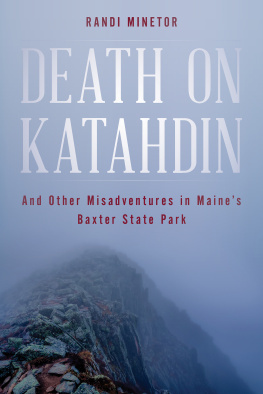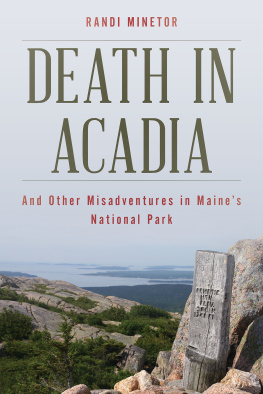Death on Katahdin
Death on Katahdin
And Other Misadventures in Maines Baxter State Park
Randi Minetor

Camden, Maine

An imprint of The Rowman & Littlefield Publishing Group, Inc.
4501 Forbes Blvd., Ste. 200
Lanham, MD 20706
www.rowman.com
Distributed by NATIONAL BOOK NETWORK
Copyright 2018 Randi Minetor
All rights reserved. No part of this book may be reproduced in any form or by any electronic or mechanical means, including information storage and retrieval systems, without written permission from the publisher, except by a reviewer who may quote passages in a review.
British Library Cataloguing in Publication Information available
Library of Congress Cataloging-in-Publication Data available
ISBN 978-1-60893-417-1 (paperback)
ISBN 978-1-60893-418-8 (e-book)
 The paper used in this publication meets the minimum requirements of American National Standard for Information SciencesPermanence of Paper for Printed Library Materials, ANSI/NISO Z39.48-1992.
The paper used in this publication meets the minimum requirements of American National Standard for Information SciencesPermanence of Paper for Printed Library Materials, ANSI/NISO Z39.48-1992.
Printed in the United States of America
I dedicate this book to all the archivists, historians, and reference and local history librarians who bring to their work a boundless enthusiasm for the scavenger hunt that is historical research. You have my utmost respect and gratitude for your help in making my work possible.
Contents
Acknowledgments
What a pleasure it is to write about the Maine north woods, especially because I had an unusually generous amount of assistance while researching the stories in this book.
First, the staff at Baxter State Park pointed me in a number of useful directions to find documents and media coverage, helping me fill in the details about incidents that took place decades before they became employees of the park.
Local history and special collections librarian Betsy Paradis at the Bangor Public Library went out of her way to find bits of information that would not have surfaced without her knowledge of local history records. Trudy Wyman, curator of the Millinocket Historical Society, did her best to search newspapers to help me piece together the facts about several deaths in the park, which gave me a better understanding of the limits of information available in Millinocket. In the same vein, the volunteers who now run the Millinocket Public Library gave me access to physical files of fragile newspapers dating back to 1940, and the opportunity to determine that I had all the available information (scant as some of it was) helped bring the project to a satisfying conclusion.
Others who assisted with my research include Carl Langsenkamp, vice president of global public relations at Xerox Corporation, as well as Xerox archives manager Ray Brewer; and the venerable Peter Noddin, administrator of the Maine Wreck Chasers website and database, who helped me track down the details of the 1956 plane crash north of the Brothers Mountains. I thank all of these historians, as well as Craig Fuller of Aviation Archaeological Investigation and Research (AAIR) in Phoenix, Arizona, for pulling the file on the 1944 plane crash on Fort Mountain and sending me all seventy-eight pages of it.
I am especially grateful to Carol Newlin, survivor of the 1968 lightning strike in Chimney Pond Campground, and Charlie Jackson, who helped rescue her, for their willingness to talk with me about their experiences. Likewise, I thank Martha Mott Reynolds, her brother, Greg Mott, and her husband, Mike Reynolds, for so willingly sharing their familys experience in the park in July 1965. I am equally indebted to Steve Tetreault, former Baxter State Park ranger, for his vivid account of fall victim Derek Quiets recovery mission, both by phone and in his own book. I did not speak directly to Game Warden Eric Wight, but his book proved invaluable as well in filling in the gaps left by scant media coverage and pre-computer recordkeeping.
The folks at Globe Pequot Press always turn out a terrific book, so it continues to be my pleasure to work with them for the twelfth consecutive year. My editor, Michael Steere of Down East Books, and the crew including assistant editor Sarah Parke, production editor Ellen Urban, layout artist Jason Rock, copy editor Jessie Shiers, and proofreader Lauren Szalkiewicz, have all done their usual excellent job in bringing this book to fruition. And I cant say this enough: My agent, Regina Ryan, got me through the door to become a writer on this series of Death books, so I thank her once again for keeping an ear to the ground and making the proper connections on my behalf.
Finally, to the friends and family who support all of my writing endeavors: Ken Horowitz and Rose-Anne Moore, Martin Winer, Bruce Barton, Martha and Peter Schermerhorn, Paula and Rich Landis, Ruth Watson and John King, Cindy Blair, Bil Walters and Christine Tattersall, and my adorable husband, Nic Minetor, who has endured often-ghastly dinner-table descriptions of every unfortunate soul in four Death books to date... I could not do what I do without your encouragement, your indulgence, and your love. Thank you all for being such an important part of my life.
Introduction: Defying Pamola
Man is born to die, his work is short-lived.
Buildings crumble, monuments decay, wealth vanishes.
But Katahdin in all its glory forever shall remain
the mountain of the people of Maine.
Percival P. Baxter, Maine Governor 19211924
It began as a passion project by an enlightened man with the means to make it happen, and grew to become the crown jewel of a state also rich with ocean beaches, fjord-like bays and sounds, and high granite cliffs. Baxter State Park, named for the man who conceived it, preserves the deep woods and high peaks of northern Maine and now hosts upwards of 60,000 visitors in the summer months alone, including many Maine residents who return over and over to summit one more mountain, fish in one more pond, or hike a different trail to the top of Mount Katahdin.
Percival P. Baxter loved the woods and kettle ponds of northern Maine, so when he had the means and the opportunity, he purchased Katahdinyes, he bought a mountainand donated it to the state of Maine, on the condition that it be preserved as wild land forever. This first gift established the method for creating a park, so Baxter kept buying land adjacent to his original purchase. Landowners in the area saw the value in his plan and donated their own land, until the park reached its current size of 209,644 acres, or more than 320 square miles. Today most of the park serves as a wildlife sanctuary, while just under 30,000 acres are managed for sustainable scientific forestry, and more than 52,000 acres are open for hunting and trapping (except for moose, which are protected).
At 5,267 feet, Katahdin is the tallest mountain in Maineand while its size may seem less than impressive to those who frequent the much younger and higher Rocky Mountains, Katahdin towers mightily over the parks other forty-plus peaks, its summit often encircled with clouds. Its rugged trails, ice-filled gullies in winter, and changeable weather patterns make Katahdin the most challenging climb in the stateand tens of thousands of visitors rise to this challenge year-round, returning without mishap to tell the tale.
Baxter Peak stands as the topmost of the mountains multiple pinnacles, serving double duty as the terminus of the 2,189.2-mile Appalachian National Scenic Trail. Very slightly lower but even more challenging to reach, Pamola Peak forms the end of the Knife Edge, one of the Northeasts most legendary and precarious stretches of trail. At about a mile long and a mere three feet wide in spots, with granite ledges and boulders sloping downward for more than 1,000 feet on either side, Knife Edge stymies many who consider the option of crossing it. Many hikers, however, delight in the spectacular views of the park on either side, and in the sense that a free fall over serrated rocks could be just a misstep away.
Next page











 The paper used in this publication meets the minimum requirements of American National Standard for Information SciencesPermanence of Paper for Printed Library Materials, ANSI/NISO Z39.48-1992.
The paper used in this publication meets the minimum requirements of American National Standard for Information SciencesPermanence of Paper for Printed Library Materials, ANSI/NISO Z39.48-1992.